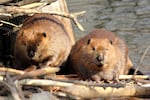
finchlake2000 / Flickr
The beaver may be Oregon's
but that status is not shielding it from being killed by the hundreds by a federal agency.
The killing could end, though, if two environmental groups prevail with their new lawsuit challenging the practice. They contend that it's harming more than just the state’s marquee mammal.
Beavers can create a lot of environmental benefits to a landscape. They build dams from sticks, mud, and rocks. That creates ponds, which provide habitat for lots of wildlife , including the federally threatened Oregon spotted frog and Oregon coast coho salmon.
“Beavers are such amazing little creatures,” said Collette Adkins, with the Center for Biological Diversity. “They’re nature’s engineers.”
That's why the center and Northwest Environmental Advocates on Thursday filed a formal notice of intent to sue Wildlife Services — a part of the U.S. Department of Agriculture.
Wildlife Services deals with human-animal conflicts. A spokeswoman didn't comment on the pending litigation but did provide information about the beaver program. Beavers, the program said, can cause a lot of damage: turning highway road culverts into dams, flooding agricultural lands and athletic fields and damaging timber.
But that can all be managed without killing beavers, the environmental groups said. Through a Freedom of Information request for public documents, they discovered that Wildlife Services killed more than 400 beavers in Oregon in 2016.
Some of the most effective ways to live with beavers involve methods of maintaining drainage near their ponds, said Nina Bell, with Northwest Environmental Advocates.
“(Beavers) belong everywhere,” Bell said. “And if we keep thinking that they don’t belong where we are — and we, people, are everywhere — then that does not bode well for the beavers.”
American beavers — the continent's largest rodent — provide particularly good habitat for rearing juvenile salmon by slowing down stream channels, according to NOAA Fisheries.
“We should be restoring beaver populations, not targeting them for cruel deaths with leg hold traps and other awful devices set by (Wildlife Services),” Adkins said.
The groups want Wildlife Services to look at how killing beavers in Oregon can harm threatened and endangered species, a requirement of the Endangered Species Act. They also want the federal government to use more non-lethal methods to control beaver conflicts.
In a 2006 report, the Oregon branch of Wildlife Services listed "protecting timber from bear and beaver damage" as one of its top priorities.
But in a 2015 report, it said one of the top research projects in the state was "evaluating the importance of beaver to the life history of salmon and steelhead."
Adkins said they will continue to look at how beavers are managed in other states.
The federal government now has 60 days to respond.

